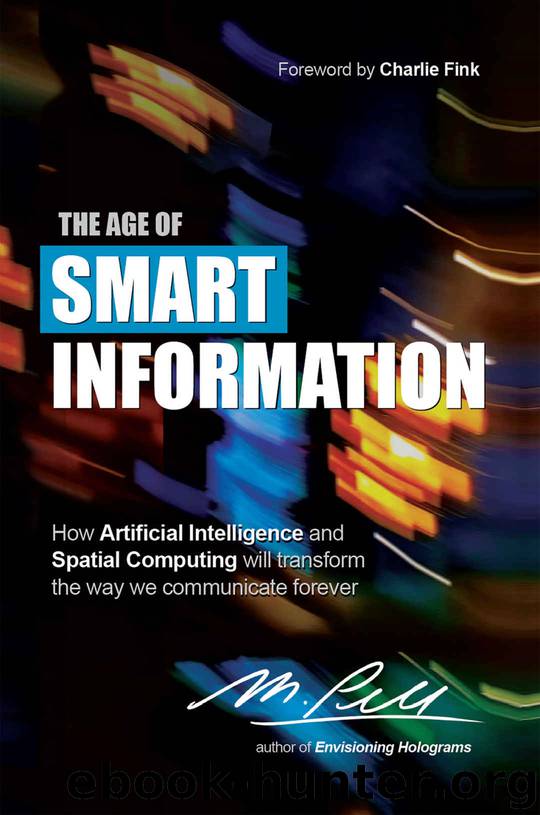The Age of Smart Information: How Artificial Intelligence and Spatial Computing will transform the way we communicate forever by Pell M

Author:Pell, M.
Language: eng
Format: epub
Publisher: epubor.com
Pivotal Decisions
A key part of the intelligence applied to Smart Information is its ability to choose the right form of information to present (audio, photo, video, haptic, etc.) for a given situation. That’s always a pivotal decision in the communication process. It’s also one of the determining factors for whether we are being clear or not. Getting these decisions right consistently has everything to do with how “good” this system is considered to be over time. Making a solid connection while communicating goes a long way.
We can’t afford to get this initial decision of what to present wrong – but we will. Our efforts here will certainly improve over time with the help of Machine Learning on the backend and Reinforcement Learning on the frontend, but to start there will be a lot of experimentation on form. So, for now let’s focus our built-in intelligence on solving for the right thing - clarity. In order to do that, we have several basic questions to run through each time.
Who? Just like any decision made about how to communicate effectively, we should start by evaluating who is listening or paying attention. Do we know anything about them? If so, what specifically can we use to establish a connection to engage them early? In a Smart Information system, you potentially have secure access to a great deal of approved background on the person or audience to be sorted through. Our goal here is to customize and personalize our initial form to feel exactly right for its target. The digital object will know that I prefer summaries and brief overviews rather than someone like you who might like more detail by default.
Why? Every experience design opportunity should start with asking the obvious question – Why are we doing this? In this case, knowing what the person is doing currently (i.e. walking down the street) helps us to understand the context of why they may be asking a particular question or requesting certain information. That helps the AI connect the dots to infer potential scenarios.
In many common cases, it will be completely obvious why this information was asked for – it’s the answer to a direct question. Other times it will be somewhat mysterious, with lots of room for error in interpreting. That’s where great design comes in – being ready to ask a clarifying question, pivot into a new format, show a different level of detail, or even time shift some aspect of the interaction to make it easier to answer. I asked for directions to that restaurant when I was at work to see how long it would take to get there, but now that I’m on my way I’m much more interested in some landmarks along the way to help me find the place. The question remained the same – the answer should have morphed over time to fit the circumstances.
When? The exact time something is being asked for will determine a great deal about the form of the answer. If we
Download
This site does not store any files on its server. We only index and link to content provided by other sites. Please contact the content providers to delete copyright contents if any and email us, we'll remove relevant links or contents immediately.
| Computer Vision & Pattern Recognition | Expert Systems |
| Intelligence & Semantics | Machine Theory |
| Natural Language Processing | Neural Networks |
Algorithms of the Intelligent Web by Haralambos Marmanis;Dmitry Babenko(8301)
Test-Driven Development with Java by Alan Mellor(6728)
Data Augmentation with Python by Duc Haba(6641)
Principles of Data Fabric by Sonia Mezzetta(6392)
Learn Blender Simulations the Right Way by Stephen Pearson(6292)
Microservices with Spring Boot 3 and Spring Cloud by Magnus Larsson(6165)
Hadoop in Practice by Alex Holmes(5958)
Jquery UI in Action : Master the concepts Of Jquery UI: A Step By Step Approach by ANMOL GOYAL(5807)
RPA Solution Architect's Handbook by Sachin Sahgal(5561)
Big Data Analysis with Python by Ivan Marin(5367)
The Infinite Retina by Robert Scoble Irena Cronin(5252)
Life 3.0: Being Human in the Age of Artificial Intelligence by Tegmark Max(5147)
Pretrain Vision and Large Language Models in Python by Emily Webber(4330)
Infrastructure as Code for Beginners by Russ McKendrick(4091)
Functional Programming in JavaScript by Mantyla Dan(4038)
The Age of Surveillance Capitalism by Shoshana Zuboff(3955)
WordPress Plugin Development Cookbook by Yannick Lefebvre(3805)
Embracing Microservices Design by Ovais Mehboob Ahmed Khan Nabil Siddiqui and Timothy Oleson(3609)
Applied Machine Learning for Healthcare and Life Sciences Using AWS by Ujjwal Ratan(3580)
